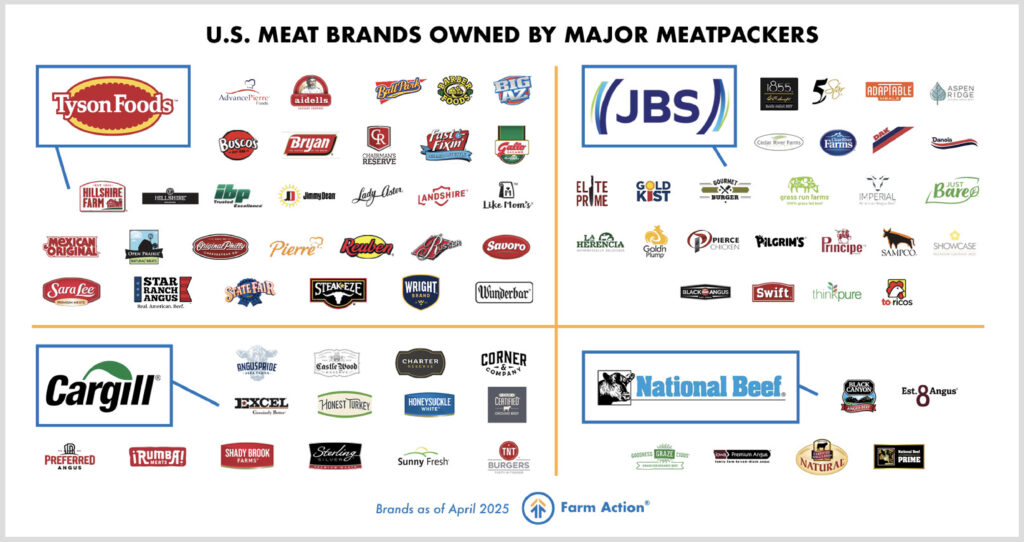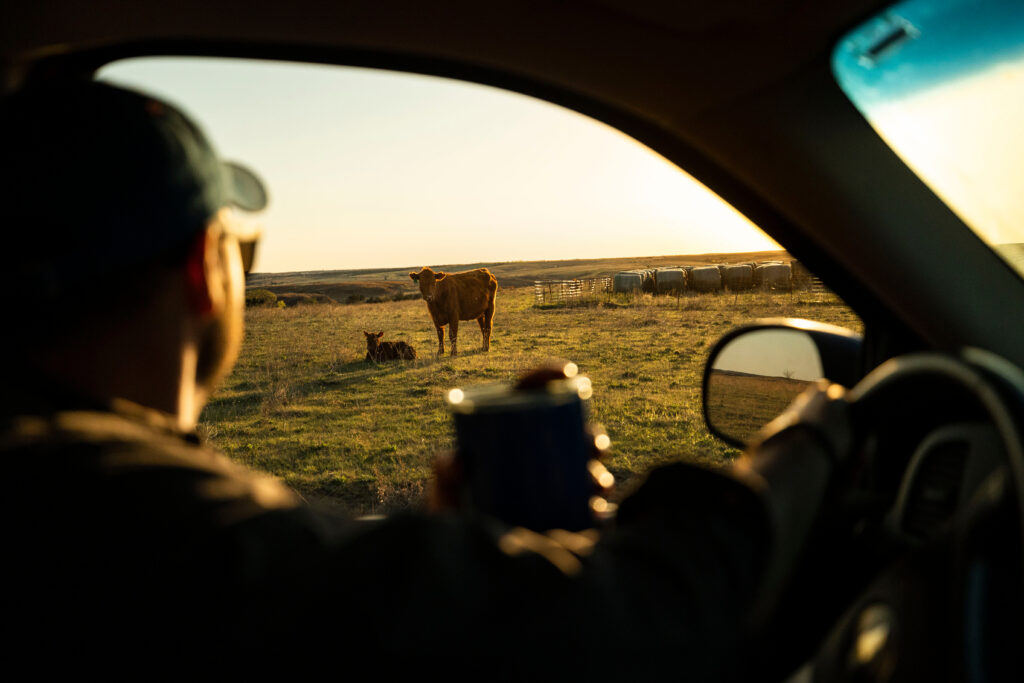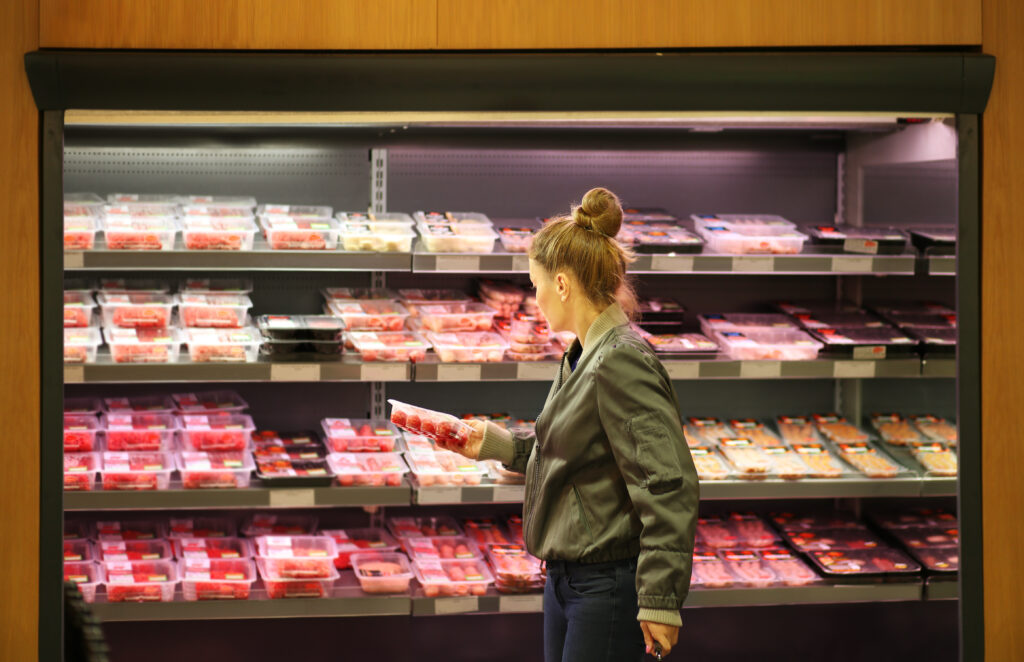Summer is just around the corner, sending droves of shoppers to the grocery store to kick off the barbecue season. For many, it may seem like the shelves are lined with endless choices of brands to pick from.
But whether you’re shopping for meats, fresh vegetables, or prepared foods, did you know that just a handful of giant corporations are behind your favorite brands? Not only is this lack of choice deceptive—it causes real harm to farmers, workers, and consumers alike.
The Illusion of Choice
When we pull back the curtain, only a handful of powerful companies own the sea of options we find at the grocery store. For example:
- Carrots: Two companies control 60% of the carrot supply.
- Prepared soups: Four companies own 70% of the prepared soups market.
- Almond milk: A whopping 81% of almond milk is owned by four companies.
- Dips: PepsiCo, with its popular brands like Tostitos, Lay’s, and Fritos, controls 88% of the dip market.
This illusion of choice stems from decades of lax antitrust enforcement that led to a wave of unchecked mergers and acquisitions across nearly all sectors of the food system. As these companies grew larger and more profitable, they accrued more power and influence. This undue power has enabled mega-corporations to rake in record profits by squeezing farmers and workers and charging consumers more at the grocery store.
Spotlight on Meatpacking: The Big Four
Meatpacking is one of the most consolidated industries in our food system. Of the more than 70 meat brands marketing to consumers and retailers under the guise of individual names and logos, just four corporations—Tyson, JBS, Cargill, and National Beef—are behind these brands.
These four meatpacking giants control a staggering 80-85% of the beef industry. They routinely make headlines for their abusive behaviors, from getting sued by other corporate goliaths like McDonald’s for price-fixing to lawsuits over the use of child labor in their meatpacking plants.
But these companies’ sheer dominance over this industry, deceptively hidden behind their acquired brands, means that it’s challenging to opt out of buying their products at the grocery store.
This level of corporate control in the meatpacking sector has devastated the industry: Farmers have been driven off their land, prices have increased for consumers, and our food supply is vulnerable to disruptions.
How Did We Get Here?
Believe it or not, we’ve actually been here before. In the early 1900s, a “Meat Trust” of five dominant meatpackers controlled the livestock and poultry sector. But public outcry led to regulations like the Packers and Stockyards Act of 1921 and antitrust legal action, which successfully broke up that oligopoly.
However, this all began to change in the 1980s when weakened antitrust enforcement led to a new wave of consolidation through a series of mergers and acquisitions. By 1990, four firms—IBP, Cargill, ConAgra, and National Beef—controlled 70% of cattle processing in the U.S. Today, the “Big Four” remain entrenched and have consolidated further, with only their names changing through acquisitions. For example, Tyson acquired IBP, and JBS absorbed multiple competitors. The effects of the meatpacking monopoly are nowhere as clear as in the beef industry.
Impacts of Beef Industry Consolidation on Farmers and Consumers
The consolidation of the beef industry continues to harm farmers and consumers as this corporate power remains largely unchecked.
While it may appear to the consumer that a cattle rancher has many options for where to sell their livestock, in reality, it’s a bottleneck. There are few options for ranchers to sell to, which limits their ability to seek better pricing or terms from competing companies. This means that ranchers often have little choice but to accept the short end of the stick.
This transformation of our livestock markets has dramatically undermined the viability of smaller and midsize operations, driving hardworking farmers and ranchers off the land. Between 2002 and 2022, roughly 58,000 feedlots (72%), 18,000 hog farms (23%), and 56,000 dairy farms (61%) exited the market, yet our livestock production has not decreased in tandem. Instead, we simply have fewer operations producing the vast majority of our food supply.
For consumers, this consolidation leaves our food system highly vulnerable to supply chain disruptions. For example, when a Tyson beef processing plant in Holcomb, Kansas—which was responsible for five to six percent of beef processed in the U.S.—caught fire in 2019, it caused market panic and price spikes.
A market with fewer players also makes coordination easier, allowing the few dominant corporations to push up consumer prices and drive down farmers’ share of the consumer dollar. This market manipulation isn’t just speculative: The Big Four settle many price-fixing lawsuits each year, with settlements between the Big Four reaching hundreds of millions of dollars in 2025 alone.
While consumers pay more at checkout, those extra dollars are not making it to farmers. Whereas 70% of the consumer’s beef dollar went to cattle ranchers in 1970, today, ranchers’ share of the consumer dollar is closer to 30%.
What Can You Do?
Understanding who controls our food is the first step. To learn more about the unprecedented consolidation of each sector of our food and farm system, visit Farm Action’s Agriculture Consolidation Data Hub. For those who are able, you can support local farmers directly by shopping at farmstands, farmers markets, or by purchasing shares from local Community Supported Agriculture (CSA).
Written by Jessica Cusworth. Research by Emma Nicolas, Sarah Carden, and Christian Lovell. Concept by Emma Nicolas.





